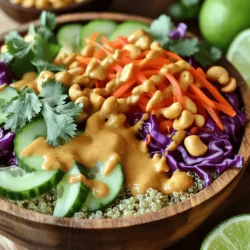Delight in the flavors of Thai Peanut Buddha Bowls with this easy recipe! Packed with nutritious quinoa, colorful veggies, and a creamy peanut sauce, it's a perfect meal for any day. Discover how to assemble these delicious bowls step-by-step, and learn presentation tips that will make your dish pop. Click through to explore this enticing recipe and bring vibrant flavors to your table today!
1 cup quinoa, rinsed
2 cups vegetable broth
1 cup shredded carrots
1 cup red cabbage, thinly sliced
1 bell pepper (red or yellow), sliced
1 cucumber, diced
1 cup edamame (shelled)
1/4 cup fresh cilantro, chopped
1/4 cup roasted peanuts, chopped (for topping)
For the Peanut Sauce:
1/4 cup creamy peanut butter
2 tablespoons soy sauce (or tamari for gluten-free)
1 tablespoon maple syrup
2 tablespoons rice vinegar
1 teaspoon sesame oil
1-2 teaspoons sriracha (to taste)
Water for thinning, if needed
